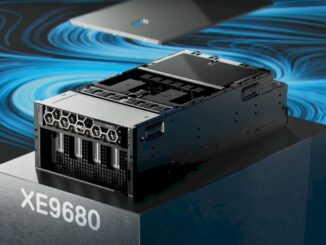
When Dell acquired EMC in its massive $60 billon-plus deal last year, it boasted that Dell was inheriting a boatload of new technologies that would help propel forward its capabilities and ambitions with larger enterprises.
That included offerings ranging from VMware’s NSX software-defined networking (SDN) platform to VirtuStream and its cloud technologies for running mission critical applications from the likes of Oracle, SAP and Microsoft off-premises. In particular, Dell was acquiring EMC’s broad and highly popular storage portfolio, in particular the high-end VMAX, XtremeIO, and newer ScaleIO lineups as well as its Isilon storage arrays for high performance workloads.
Dell had a long-established presence in midrange businesses across its product portfolio, and one of the driving forces behind buying EMC was the storage giant’s strong base of larger enterprise customers. In fact, Dell had established storage offerings for the midrange and small business sectors, including the technologies is acquired when the company bought Compellent in 2010. With EMC in the fold, Dell now can boast as large a storage portfolio as anyone in the industry.
Since the deal, there has been ongoing speculation about what Dell EMC would do with the various storage lines, particularly in the midrange, where the overlap was greatest. For the time being, the decision seems to be to stand pat: for now at least, the company will move forward with both its Unity platform from EMC and Dell’s Compellent SC line. At this week’s Dell EMC World conference, which comes just months after the close of the merger, Dell showed what it had planned for the high-end systems, rolling out upgrades to many of its storage lines, with a particular emphasis on flash. It followed the push that already was ongoing at EMC before the deal closed. Officials with EMC last year declared that 2016 would be the year of all flash for the company, and now Dell EMC appears determined to continue that trend this year.
The company added to its VMAX all-flash lineup with the new VMAX 950F, which includes the latest processors from Intel and comes with what executives said are 68 percent better performance, 30 percent faster response times and a 25 percent smaller footprint. The company also introduced XtremeIO X2that comes with new hardware and software, better performance and greater capacity, and a new architecture dubbed “Infinity” for the Isilon NAS systems that includes all-flash, hybrid and archive configurations.
Flash has grown in popularity in recent years as enterprises have modernized their datacenters and workloads, more capabilities – such as deduplication and compression – have been added and prices have dropped to be more competitive with disk. Dell EMC is seeing the growing demand for the technology, with more than 80 percent of VMAX purchases now being all-flash offerings, according to Caitlin Gordon, director of marketing of enterprise storage at the company.
However, even as Dell continues to aggressively expand the availability of flash throughout the storage product portfolios, officials are increasing their attention on what’s coming next. That includes the use of such technologies as GPU accelerators, for example, but what’s really interesting is NVM-Express, Gordon tells The Next Platform. The technology promises huge boosts in performance and lowering of latency of flash storage, and vendors are starting to embrace it. Many are waiting commercial dual-ported NVMe flash SSDs to hit the market later this year, but as we noted last month, officials with Pure Storage, which has become a constant annoyance to Dell EMC in the storage space, said they are creating their own flash modules that support a variant of NVMe for its FlashArray line.
For its part, Dell EMC is reworking its thinking on NVMe. Last year, EMC – before the acquisition – unveiled the DSSD D5, an all-NVMe flash storage array that was designed for some HPC and enterprise workloads – think simulation, machine learning and data analytics – and delivered high performance, high availability and low latency. Most flash cards and SSDs rely on legacy SCSI protocols, but NVMe enables more direct communication between compute and flash memory, and can be connected to the nodes via PCIe Gen 3. However, just a year after its debut, Dell EMC in March ended production of the DSSD D5, in part because of economics. The arrays were expensive, and few businesses had the money to buy them or the workloads to take advantage of them.
Instead, Dell EMC officials are looking to incorporate NVMe in its existing lines of storage products, including the ScaleIO products, Gordon said, adding that the protocol should be integrated into the software-defined storage (SDS) lineup by the end of the year. NVMe eventually will be a core technology in high-end storage arrays, but it will take time, Gordon said. Right now, “NVMe is the 4K of TVs,” she said, adding that while people are buying 4K televisions now, there isn’t much content that can advantage of the advanced technology, which means consumers are spending a lot of money for technology they can’t yet use. “NVMe certainly will become important in the datacenter at some point in the future. There’s a lot of buzz around it right now, but it’s not the reality.”
NVMe is similar to the 4K televisions or smartphones powered by chips with eight or ten cores but without the software that can take advantage of such processing power. It all sounds great, but with 4K, it takes more than a single component to make it worthwhile – you need the content, receiver and network to support it as well. Similarly, with NVMe, users need more than simply having SSDs with NVMe variants. Other things need to come into play, from the OS and software that is optimized for parallelization, connectivity between array controllers and drives that can take advantage of the low latencies delivered by NVMe, servers that are optimized for NVMe and SSDs that are fast and stable enough for the protocol, Gordon said. “You can’t just put NVMe in one part of your array,” she said. “It needs to be throughout the entire stack.”
In a recent blog post, Gordon pointed out areas in the enterprise where NVMe can be beneficial today – using the protocol to quickly protect data to persistent memory, as a caching tier and for custom applications that can be developed to leverage NVMe and that can run on a server that includes NVMe drives. But the longer-term, broader benefits of NVMe to the enterprise are farther down the road. They’re coming, but until then, organizations shouldn’t expect to see significant leaps in performance and latency in their NVMe-enabled arrays.





Jeffrey, the Pure Storage NVMe flash modules are released and running customer production workloads already. The article should be edited to reflect that fact and not make it seem like it is just a product announcement, as is the case with Dell EMC
HIGH PERFORMANCE due to VMAX 950F due to its high effectiveness and latest technology.
Great future of Dell